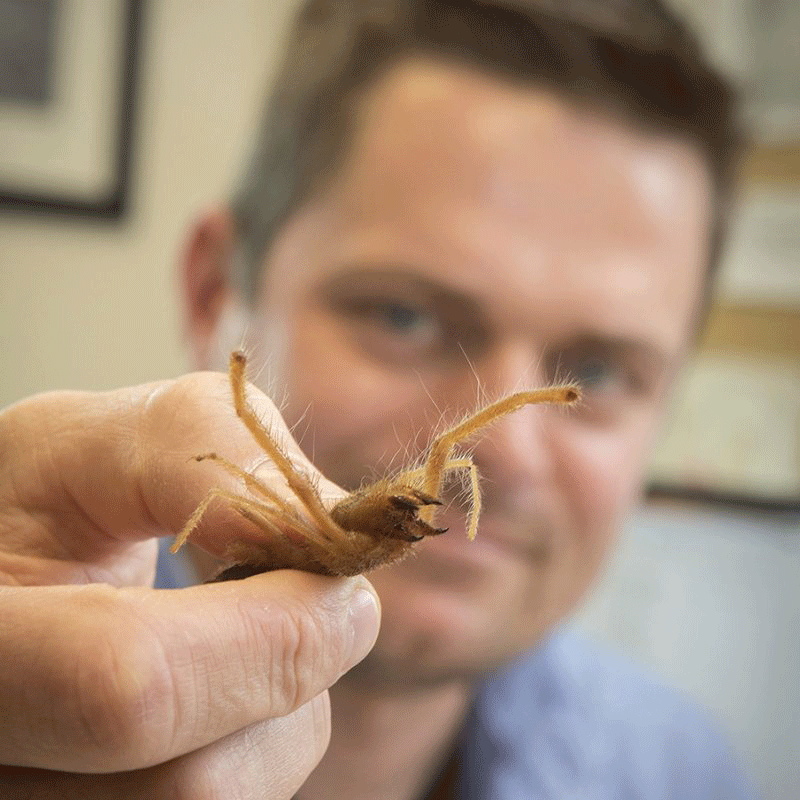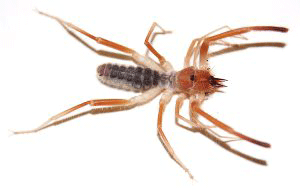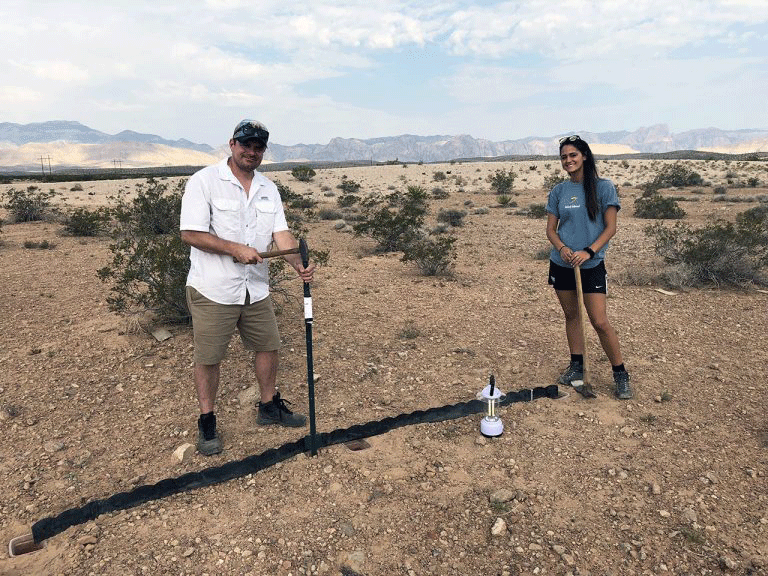- Apply
- Visit
- Request Info
- Give
Eastern Receives Major NSF Grant to Study Camel Spiders
Written by Michael Rouleau
Published on September 28, 2018

The camel spiders being studied at Eastern are preserved in ethanol. This specimen, held by Biology Professor Matthew Graham, has a large chelicerae — jaw-like appendage used for catching food.
Eastern Connecticut State University is the recipient of a major grant from the National Science Foundation (NSF) to fund research on a little-known type of arachnid known as the camel spider. Led by Biology Professor Matthew Graham, the grant will total more than $500,000 over the course of four years in an effort that will develop young scientists and contribute to the understanding of climate change in deserts.
The project is a collaboration between Graham’s lab at Eastern, the Denver Museum of Nature and Science and the University of Colorado. With more than $1 million in NSF funding split between the Connecticut- and Colorado-based teams, the project represents cutting-edge research that could well make an impact on the global stage.
Camel spiders are actually not spiders at all, but another type of arachnid called solifuges. While they do have eight legs and are in fact arachnids, solifuges don’t have venom or make silk (webs) — unlike their spider relatives. Their most obvious difference, however, is the presence of enlarged chelicerae — ferocious jaw-like appendages — rather than venomous fangs.

Camel spiders do not have 10 legs; the right-most appendages are used for smelling and feeling their environment. Scientists recently found that they also act like suction cups.
Native to deserts and arid habitats throughout the world, camel spiders — also known as sun spiders and wind scorpions — are an understudied taxonomical group, as they are notoriously difficult to find, collect and keep alive in captivity.
Unlike their scorpion relatives, which can survive for months with no food or water, camel spiders have high metabolisms and voracious appetites, and are a challenge to study in a laboratory setting.
One of the NSF’s initiatives is to investigate understudied organisms. Graham and colleagues are tasked with understanding how changing desert landscapes and climates have shaped the evolution of camel spiders. Doing so can help predict how they — and desert ecosystems at large — will respond to global climate change, as well as inform desert-conservation efforts.
“Deserts of the American Southwest are my passion,” said Graham, who is an expert on scorpions. “I’ve been collecting scorpions throughout these deserts and using DNA to learn about their evolutionary history. But scorpions are one piece of the puzzle. Now that we’ve got them somewhat figured out, we can look at other arachnids.”
As the NSF-funded arachnologists study camel spiders, other scientists are beginning to use genomic techniques to look at desert mammals and reptiles. “Together,” said Graham, “we should begin to understand how our desert ecosystems formed, how they have changed, and how they respond to ongoing and future climate change.”

Graham’s team at Eastern will focus on camel spiders of the American Southwest. The team consists of a soon-to-be-hired postdoctoral scholar who will work full time on the project; an REU student from Eastern — REU stands for Research Experience for Undergraduates, which is an intensive NSF research program — and other Eastern undergraduates who are conducting research with Graham for independent study credits.
The second team, led by Paula Cushing and her colleagues at the Denver Museum of Nature and Science, as well as graduate students from the University of Colorado, will focus on understanding the relationships among North American camel spiders and the discovery of new species.
“The most important thing Eastern is getting out of this is student training in some very marketable laboratory skills,” said Graham. “The genomics techniques they are learning are really powerful and generate exponentially more data than traditional approaches.”
Genomics is a branch of molecular biology focusing on the structure, function, evolution and mapping of genomes. A genome is an organism’s complete set of DNA, including all of its genes.
As part of the project, the Eastern team will travel to deserts of the United States and Mexico to trap specimens. This past summer in the Mojave Desert, Graham and Eastern biology student Michelina Pinto used a new method to trap camel spiders, which resulted in many more collections. Their method involves installing pitfall traps with lights (lures) above them. Graham, Pinto and Cushing co-authored a manuscript describing the technique and recently submitted it for publication in a scientific journal.
After specimens have been collected, they are preserved in ethanol and sent to Cushing’s team in Denver for species identification. Back at Eastern, the genome is extracted from muscle tissue using a laboratory procedure. The genome occurs as long strands of DNA. Using special enzymes, which Graham describes as “tiny molecular scissors,” they’ll chop up the DNA into manageable pieces and tag them with molecular barcodes before sending them off campus for DNA sequencing.
“After sequencing, we’re going to have tons of DNA data,” said Graham. “We hope to team up with our math department and use bioinformatics to analyze all this data. Patterns in the DNA will show us how populations of these desert animals have responded to climate change.”
Graham’s team will perform this process on numerous samples collected from deserts across the Southwest. They will return to the Mojave and other arid landscapes throughout the American Southwest over the next four years, as well as go on an extensive sampling expedition along the Baja California peninsula in 2020.
“A lot of what we thought we knew about camel spiders turned out to be wrong,” said Graham, referring to new science that has rejected previous assumptions about solifuges.
The primary goals of the project are to (1) revise the taxonomy (classification) of species of North American camel spiders, (2) provide new online resources about their biology, (3) expand digital records within the NSF’s arthropod database, (4) create an online guide to camel spiders of North America, and (5) inspire and train the next generation of arachnologists.
For more information, visit http://www.solifugae.info/proposal%201733117.html.


